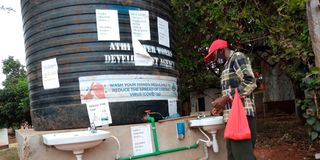Premium
Half of health facilities in seven counties lack clean water

A water tank where the members of the public are supposed to wash their hands at Mbeere sub-county Hospital in Embu County.
Four of 10 facilities surveyed in seven counties do not have adequate clean water, says a report on infection prevention and control in healthcare facilities launched on Wednesday.
Of the facilities that have clean water, only 50 per cent have safe water.
The survey was done in seven counties that have high diarrhoea cases: Nyamira, Homa Bay, Kisumu, Nakuru, Machakos, Kiambu and Kajiado.
It revealed that 60 per cent did not have adequate handwashing stations, and 62 per cent lacked functioning hygiene stations at points of care.
Of 10 facilities, five did not have a dedicated decontamination area, and 21 per cent did not have reliable sterile material supply or sterilization equipment.
The survey involved 91 public health facilities from levels two to five. There were 35 level two, level three (28), level four (21) and level five (7). Participants in the assessment were people in charge of the health facilities.
“Though the availability of safe and clean water increases with the level of care, there remains a considerable proportion of facilities with less than adequate safe and clean water at 50 per cent,” says the report
If facilities have unsafe water, healthcare workers and their clients are exposed to infection. Consequently, most medical procedures may be a source of infection, including directly observed therapy (DOT) for tuberculosis treatment
Kisumu recorded the highest access to safe water (92 per cent), which means out of 10 facilities surveyed in that county, nine had safe water. Three counties had the least: Nyamira (31 per cent), Homa Bay (23 per cent), Nakuru (15 per cent).
“Adequate clean water, safe sanitation and good hygiene in health care facilities are fundamental to infection prevention and control (IPC) of waterborne diseases and hospital-acquired infections as the backbone of patient safety,” says the report.
The situation in most facilities is dire, with the assessment laying bare some of the inequalities that exist among counties and across levels of care, said Dr Patrick Amoth, acting director-general in the Ministry of Health.
“This trend indicates that healthcare workers and their clients are at risk of infection due to unsafe water supply across all levels of healthcare,” Dr Amoth said.
The report comes as Kenya is still dealing with the Covid-19 pandemic, has reported a cholera outbreak and is on high alert for the Ebola virus that was reported in Uganda.
“If we really need to achieve Universal Health Coverage, then we must ensure that level two hospitals have safe and running water since these are facilities that are mostly visited by Kenyans. If they lack safe water, then infections start from there,” Dr Amoth said.
Of the facilities surveyed, only 50 per cent had improved latrines for outpatient patients and a toilet per 20 users for inpatients, with most of the toilets lacking supplies for anal cleansing.
“Lack of toilets and unreliable toilets results in the use of open defecation which increases the risk of diseases to the users,” the report says.
“Open defecation from the facilities considered environmental reservoirs are sources of resistant pathogens and resistance genes and studies have established a link between improper sanitation and antimicrobial resistance in health care settings.”
Level five facilities recorded the highest availability of toilets (83 per cent). This reduced through the levels of care, with level four recording 40 per cent.
Of the counties surveyed, only Nakuru and Kajiado had above average coverage at 62 per cent and 54 per cent respectively.
Hygiene protocals
The majority (80 per cent) of the assessed facilities did not have hand hygiene protocols in place.
“This is an indication that most of the facilities may not be aware of the need for hand hygiene protocols which could lead to poor hygiene practices,” the report says.
“The assessment revealed that availability of hygiene protocols improved with the level of care, from level 2 at 13 per cent and Level 5 at 50 per cent.”
The overall availability of hand hygiene protocols was highest in Kajiado (38 per cent). Homa Bay and Kisumu were each at eight per cent, indicating low availability of hand hygiene protocols.
The assessment also found that only a small proportion of the facilities (20 per cent) had adequate hand hygiene facilities within the healthcare waste disposal area, indicating critically low hand hygiene practices.
“Healthcare waste is a potential reservoir of pathogenic microorganisms and requires appropriate, safe, and reliable handling. Safe management of healthcare waste is a key issue in controlling and reducing hospital-acquired infections,” Dr Amoth said.
The availability of functional hand hygiene stations at waste disposal areas was highest at 67 per cent at level five, less than 20 per cent in all other levels of care, and the lowest at level four (6.7 per cent).
“This implies that the waste handlers may not wash their hands and equipment that carry the wastes regularly thus could be a high potential source of infection within our healthcare settings, thus exposing the healthcare waste handlers and the entire healthcare providers and those seeking care within the facilities,” the report says.
Hospital-acquired infections contribute to avoidable morbidity and mortality, an unnecessary burden on the health system that also adds constraints on household resources.
To achieve the national and global universal target of 80 per cent coverage by 2025 and 100 per cent by 2030, basic hygiene and handwashing services must be integrated into the development processes such as the County Development Integrated Plans.
“It has been shown that for every dollar invested in these basic services, there is a 15 dollars return,” Dr Amoth said.




